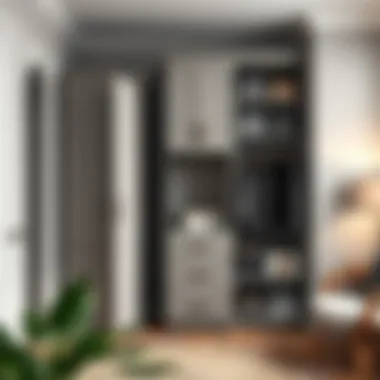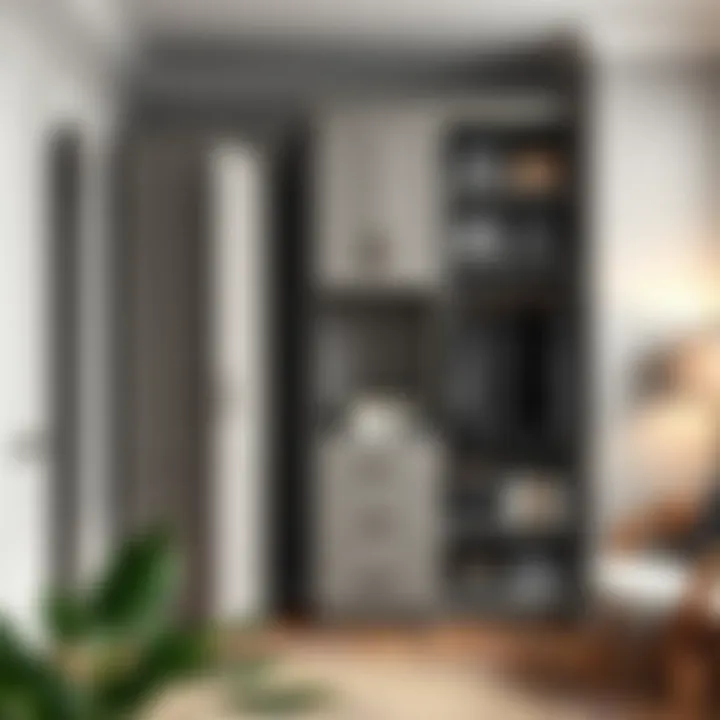Utility Closet Cabinets: Design and Storage Tips


Intro
Utility closet cabinets play a critical role in maintaining organization and efficiency in our homes, often overlooked but incredibly valuable. These cabinets serve as multipurpose storage solutions, catering to various needs while fitting seamlessly into diverse spaces. With the right design, style, and thoughtful placement, they can maximize every square inch of space available. Homeowners, designers, and DIY enthusiasts alike will find that understanding the nuances of utility closet cabinets is essential for transforming a cluttered area into a functional haven.
As we journey through this guide, we will explore various aspects of utility closet cabinets. From design trends that are currently making waves in home décor to practical buying tips for selecting the best fit for your household, you’ll find a wealth of insights. Our discussion will cover materials, dimensions, and customization options tailored to individual tastes and practical needs. Indeed, the aim is to empower you with the knowledge to make informed decisions as you consider integrating utility closet cabinets into your home’s design.
Let’s dive deep into the design trends shaping the world of storage solutions.
Understanding the Utility Closet Cabinet
When it comes to home organization, utility closet cabinets often play a subtle but vital role. These cabinets do more than just serve a purpose; they are instrumental in creating a structured environment within the home. By harnessing the full potential of these cabinets, individuals can maximize their storage capabilities while maintaining an aesthetics that speaks to their personal style.
Utility closet cabinets, typically found in immediate proximity to areas requiring organizational clarity—like laundry rooms, foyers, or even garages—can house items ranging from cleaning supplies to seasonal decorations. Understanding why these cabinets are important can help homeowners make informed decisions regarding design, placement, and functionality.
Defining Its Purpose
Utility closet cabinets primarily serve as a means of organization. However, their purposes are multifaceted:
- Storage Solutions: They provide designated space for everyday items, reducing clutter and creating a more engaging living space.
- Accessibility: With everything stored neatly, accessing frequently used items becomes a breeze, saving time and effort.
- Aesthetic Contribution: Depending on the design, these cabinets can seamlessly blend into the home’s overall decor, enhancing its visual appeal.
- Functionality: A well-organized utility closet cabinet ensures that the right tools and supplies are easily at hand, which is particularly important in fast-paced environments.
By clearly defining the purpose of utility closet cabinets, homeowners can better appreciate their value as not just mere storage but essential components in cultivating a tidy atmosphere.
Historical Context and Evolution
The concept of utility closet cabinets has evolved significantly over the years. In the past, storage furniture was bland, often only focused on functionality without consideration for style. However, with the rise of modern design trends in the late 20th century, cabinetry began to transform.
- Early Cabinets: Initially, utility cabinets were utilitarian in design, often made from simple wood structures that lacked the elegance of contemporary pieces.
- Mid-century Shifts: During the mid-1900s, a push towards more functional yet stylish designs gained momentum. Designers recognized the need for furniture that could serve aesthetic and practical purposes.
- Modernization: Today, utility closet cabinets can be seen in an array of materials and styles, from sleek laminate options to custom wooden cabinetry. They reflect not only a homeowner's needs but also preferences in quality and design.
This evolution highlights how utility closet cabinets have transitioned into an integral aspect of home decor and functionality. No longer just about storage, they've become a testament to style, marrying form and function in a way that resonates in today’s homes.
In essence, understanding the utility closet cabinet goes beyond merely knowing its purpose; it involves recognizing its role in the historical narrative of home organization and design. This foundational comprehension sets the stage for further exploration of design options, materials, and practical applications.
Design Options and Styles
Choosing the right design for your utility closet cabinet is akin to fitting a key into a lock. It’s not just about functionality; style matters just as much. The aesthetic appeal of a cabinet can enhance the overall look of your space, transforming a mere storage area into something visually pleasing. Moreover, good design aids not only in organization but also improves the usability of the closet, making the chaos of everyday items more manageable.
When it comes to styles, homeowners today have a vast array of choices. It’s important to select a design that reflects both personal taste and the existing decor of your home. In this guide, we’ll explore three main styles: contemporary designs, traditional aesthetics, and custom cabinet solutions.
Contemporary Designs
Contemporary designs epitomize the mantra of less is more. Characterized by clean lines, minimal decoration, and functional forms, they are all about showcasing the beauty of simplicity. One remarkable feature of contemporary cabinets is the use of materials that are sleek and easy to maintain. A high-gloss finish, for instance, can reflect light beautifully, making your closet feel larger and more open.
Materials such as engineered wood, glass, and metals are prominent in contemporary designs. Imagine a utility cabinet with smooth, white sliding doors paired with polished metal handles. Not only does it lend an air of sophistication, but it can also create a seamless transition from utility spaces to the rest of your home.
Benefits of Contemporary Designs:
- Versatile: Suits various decor styles from modern to industrial.
- Functional: Streamlined designs often provide more usable space.
- Easy to Clean: Smooth surfaces make maintenance a breeze.
Traditional Aesthetics
On the other end of the spectrum lies traditional aesthetics. This style brings warmth and charm, often incorporating ornate details and a sense of craftsmanship. Think wood with rich finishes like cherry or walnut, intricate carvings, and decorative hardware. Traditional cabinets evoke comfort and can make a utility closet feel like a haven rather than just a designated storage space.
Often, traditional cabinets include features such as raised panel doors and framed outlines, giving them depth and character. They work beautifully in older homes or spaces where the decor leans towards classic styles. A well-crafted wooden utility cabinet can act as a statement piece, bridging the gap between functionality and timeless design.
Considerations for Traditional Designs:
- Space Requirement: May need more room for wider door swings.
- Heavier Materials: Often crafted from solid wood, which can be weighty.
- Temperature Sensitivity: Wood can expand or contract with humidity changes.
Custom Cabinet Solutions
If off-the-shelf options don’t tickle your fancy, custom cabinet solutions might be your golden ticket. Custom designs allow for total control over dimensions, materials, and functionalities. This means you can create a utility closet that meets your specific needs while fitting snugly in an unconventional space.
For instance, if you have a narrow hallway or a uniquely shaped nook, custom cabinets can make those spaces not just usable but appealing as well. With various finishes available, you can easily tailor the look to match your existing decor while optimizing storage capacity.
Smart solutions like built-in pull-out drawers, slide-out baskets, or even hidden compartments can be integrated into custom designs to maximize organization.
Perks of Custom Solutions:
- Tailored Fit: Perfectly match dimensions to odd spaces.
- Unique Styles: Stand out with a look that’s distinctly yours.
- Functional Innovations: Enhance organization with specialized features.
Materials Used in Construction


When it comes to utility closet cabinets, the materials matter a great deal. The right choice impacts durability, maintenance, and even aesthetics. Here's a closer look at the most common materials used, helping you to understand what fits your needs best.
Wooden Cabinets
Wooden cabinets have long been the gold standard for utility purposes. They offer a blend of durability and beauty that many prefer. Hardwoods like oak or maple provide a robust structure, ensuring that your cabinet can withstand wear and tear over time. On the other hand, softer woods like pine might be easier to work with, but they can dent more easily.
- Considerations:
- Finish: Wood can be stained or painted as per your preference, allowing for personal expression.
- Cost: Solid wood tends to be pricier but pays off in longevity.
- Impact on Space: The natural textures and colors of wood can warm up a utilitarian space, making it feel more inviting.
Embedded with natural beauty, wooden cabinets can become a focal point or blend seamlessly into the background depending on the finish you choose.
Laminate and MDF Options
Laminate and MDF (Medium Density Fiberboard) offer a compelling alternative to solid wood and are often more budget-friendly. Laminate cabinets feature a plastic coating over a composite material, allowing for a wide range of designs and colors that can mimic other surfaces.
- Benefits:
- Durability: Laminate is less likely to scratch and is generally resistant to moisture, making it ideal for utility closets.
- Lightweight: MDF, being lighter than wood, is easier to install.
- Uniform Finish: It provides a smooth surface that can give a modern look to your utility space.
While these materials may sound like a compromise, they often provide a balance of function and affordability.
Metal and Glass Variants
For those aiming for a more modern or industrial look, metal and glass cabinet options can be eye-catching. These materials often highlight a sleek design while offering a high degree of sturdiness.
- Pros:
- Strength and Longevity: Metal offers exceptional durability but could be subject to rust if not properly treated.
- Transparency with Glass: Glass panels can add a touch of elegance, allowing you to display items without cluttering.
- Maintenance: Both are generally easy to clean and maintain, often requiring just a simple wipe down.
"Choosing the right materials set the tone for your utility closet cabinet, balancing functionality and style will elevate your space."
Metal and glass not only looks contemporary but can also stand up to the rigors of everyday life, making them a smart choice for utility cabinets.
In summary, the materials of your utility closet cabinet can greatly influence its appearance and utility. By weighing the pros and cons of wood, laminate, MDF, metal, and glass, you can make a decision that aligns with your goals and enhances your home.
Functionality and Features
When considering utility closet cabinets, functionality and features are vital elements that can make or break its utility in your space. A cabinet is not just a piece of furniture; it acts as a central hub for storage and organization, a versatile tool designed to meet various needs, from holding cleaning supplies to providing a designated space for seasonal items. Understanding these features aids in optimizing the overall efficiency of your home.
Adjustable Shelving
One of the standout advantages of utility closet cabinets is adjustable shelving. This feature provides homeowners with the flexibility to customize storage solutions according to their personal needs. Imagine being able to easily rearrange the shelves to suit everything from bulky boxes to smaller bins. With adjustable shelving, you can accommodate taller items without needing to replace an entire cabinet.
Some cabinets also incorporate locking mechanisms for shelves, adding another layer of safety especially if children are around. The ability to change shelf heights can help in maximizing vertical space, which is often underutilized. This adaptive nature of shelving is particularly beneficial if your storage needs evolve over time.
Built-in Organization Tools
In the world of utility closet cabinets, built-in organization tools are game changers. These features can include pull-out bins, hooks, and dedicated compartments for specific items, helping to keep everything from cleaning sprays to outdoor gear neatly corralled. Think of them as the secret sauce that takes your closet from cluttered chaos to a well-ordered sanctuary.
For instance, pull-out drawers can simplify access to the back of a cabinet, preventing the common scenario of digging through stacks of items. Furthermore, including specialized compartments can help in managing smaller items that would otherwise get lost in the shuffle. When carefully designed, these tools do not just enhance organization but also facilitate a more systematic approach to maintenance and retrieval.
Accessibility and Ease of Use
The effectiveness of any utility closet cabinet hinges on its accessibility and ease of use. No one wants to struggle with heavy doors or awkwardly placed shelves when trying to grab a simple tool or item. Thus, focusing on ergonomics during the selection process is crucial. Look for features like soft-close hinges, which reduce wear and tear while enhancing convenience. Not every household needs to follow the same accessibility standards, but thinking about what might be important is key.
Investing in designs that allow for easy opening, whether it’s sliding doors or bifold options, ensures that the contents are readily available. Additionally, good lighting within the closet can bolster usability, allowing you to quickly identify what's where without the frustration of rummaging in the dark.
Ultimately, when selecting a utility closet cabinet, looking beyond aesthetics to embrace functionality and features can lead to a remarkable transformation in your home's organization.
Remember, a well-planned utility closet cabinet can make life not only simpler but also more enjoyable.
For pertainent insights into organization tactics, consider visiting reddit.com or check out design ideas on pinterest.com.
Placement Strategies
Placement of utility closet cabinets is more than just finding an empty corner. It plays a critical role in enhancing the functional aspects of your home while maximizing available space. A thoughtfully selected location for your cabinets not only organizes your belongings but can also streamline your daily routines – making it easier to grab what you need when you need it.
Common Locations in the Home
When it comes to installing a utility closet cabinet, common locations often include hallways, entrance foyers, washrooms, and even under staircases. These areas typically collect clutter, making them ideal candidates for organization solutions.


- Hallways: This often-overlooked area can become a prime storage spot. Adding cabinets here not only utilizes the space effectively but also ensures easy access to frequently used items.
- Entry Points: Installing a utility closet cabinet in an entryway can help keep shoes, bags, and keys in check. It serves as a great first impression space too.
- Laundry Rooms: Storing detergents, fabric softeners, and ironing supplies can free up counter space, turning chaos into order.
- Bathrooms: With limited space, utility cabinets can help conceal toiletries and cleaning supplies, creating a more spacious feel.
- Under Stairs: This is often the forgotten nooks of homes; cabinets in this area can serve as a perfect solution for seasonal items or miscellaneous storage.
Considerations for Space Optimization
When placing a utility closet cabinet, a little forethought can go a long way in optimizing your area. Key considerations include:
- Traffic Flow: Make sure the cabinet doesn’t obstruct foot traffic. Proper placement allows movement without hindrance.
- Height and Depth: Tailoring the cabinet’s size to the space ensures ease of access. Tall cabinets in low ceilings can feel suffocating.
- Accessibility: Consider what items you use most and position the cabinet accordingly. Items frequently used should be housed at a convenient height.
- Lighting: Shelving should not be situated in poorly lit areas. This makes it more challenging to find what you need.
- Ventilation: If you are storing cleaning supplies or other articles that may emit odors, being mindful of air circulation is crucial.
Utilizing Corner Spaces
Corner spaces are often underappreciated when it comes to maximizing storage in homes. Instead of letting these areas go to waste, they can become invaluable assets:
- Custom Cabinet Solutions: These allow for seamless integration into awaiting corners. A custom-fit cabinet can transform a neglected nook into a functional station.
- Multi-level Options: Corner cabinets can be designed with varying shelf heights, catering to different sizes of items. This versatility helps households, especially those with diverse storage needs.
- Rotating Shelves: You can invest in innovative designs that incorporate rotating mechanisms, making it easier to access everything within a corner cabinet, minimizing the awkward reaching or bending often associated with corner spaces.
- Visual Interest: Don't forget that corner cabinets can also serve an aesthetic function. You can utilize decorative finishes or stylish interiors to enhance the visual appeal of your home.
Effective placement and smart designs can turn even the most challenging spaces into a showcase of organization.
The placement strategies for utility closet cabinets should ultimately focus on optimizing space while being functional. Making the right choices can significantly enhance not only the organization of your belongings but also the overall flow and utility of your home, addressing both form and function efficiently.
Customization Techniques
Customization techniques are vital when it comes to utility closet cabinets, as they allow homeowners to tailor their storage solutions to meet their specific needs and preferences. By personalizing these cabinets, individuals can enhance both the functionality and aesthetic appeal of their spaces. Here, we focus on three areas of customization: personalizing the finish and color, incorporating decorative elements, and implementing smart storage solutions.
Personalizing the Finish and Color
When it comes to utility closet cabinets, the finish and color can make a world of difference. Selecting the right hue or texture can turn a functional piece into a stunning focal point. It’s essential to consider the surrounding decor; for instance, if the utility closet is near a brightly colored hallway, a muted or complementary finish may harmonize better than a bold choice.
Some homeowners may opt for finishes that mimic the look of natural wood or opt for a sleek, modern laminate. Each choice contributes uniquely to the overall vibe of your home. Depending on the materials, some finishes can also provide added durability against spills or scratches.
"The right finish not only beautifies but also guards against wear, enhancing the lifespan of your cabinets."
Incorporating Decorative Elements
Decorative elements add character and individuality to utility closet cabinets. This could include anything from knobs and handles that reflect personal taste to intricate molding that brings a touch of elegance. Using decorative hinges, for example, can provide an unexpected visual flourish, turning a basic requirement into a design feature.
Some individuals also benefit from painting interior sections in vibrant colors or adding wallpaper to the inside of cabinet doors. These choices turn the mundane into the imaginative, making a personal statement that speaks to one’s style.
Consider joining decorative shelving or unique storage baskets to enhance everything from organization to aesthetic appeal. Mixing and matching hardware can also help craft a one-of-a-kind look.
Smart Storage Solutions
In the realm of utility closet cabinets, smart storage solutions are crucial in making the most of available space. One main aspect is adjusting shelves to accommodate varying heights of items or utilizing pull-out racks for easy access. Modular systems can be particularly helpful, as they allow for rearrangement depending on changing storage needs.
Additionally, incorporating various compartments tailored for specific items—like power tools, cleaning supplies, or seasonal gear—can streamline organization. Hooks and pegboards can further be integrated for added versatility, ensuring everything is within arm's reach.
Ultimately, customizing utility closet cabinets creates a blend of practicality and visual appeal. It’s about transforming a simple storage solution into something that resonates with the homeowner’s indicative style while effectively managing their belongings.
Resources:
- Wikipedia on Cabinet Design
- Britannica’s Overview on Storage Solutions
- Reddit - Utility Closet Organization Ideas
Budget Considerations
When planning a utility closet cabinet, budget considerations play a vital role. After all, finding the right balance between quality, functionality, and cost can make or break a project. It’s important to look at every angle to ensure that your investment serves not just immediate needs, but also enhances the space for years to come.
Cost of Different Materials
The material you choose for your utility closet cabinet can greatly affect the overall cost. Many homeowners may not realize that not all materials come with the same price tag or durability.
- Wood: Solid wood cabinets offer a timeless look, but the price can range widely based on the type of wood, such as oak, maple, or cherry. While they can be more costly upfront, they often hold their value well.
- Laminate: These cabinets are generally more budget-friendly. They come in various designs that mimic the look of real wood but are made from particleboard or MDF covered with a plastic coating. While they may lack the authenticity of solid wood, they can be easier to clean and resistant to damage.
- Metal: Metal cabinets can provide a modern edge and are often used in garage spaces or utility areas. They are typically lower in cost than solid wood but might require special handling to prevent rust.
- Glass: Occasionally used for decorative cabinet doors, glass can introduce elegance but often adds to the material costs beyond standard designs. When incorporating glass long-term, it’s wise to consider the safety implications, especially in households with children.
The choice of material affects not only the aesthetics but also the durability and care involved, so weigh your options carefully.
DIY vs. Professional Installation
Deciding whether to tackle the installation of your utility closet cabinet yourself or hire a professional can impact your budget significantly.
- DIY Installation: This option can save you a chunk of change, especially if you're handy and have the right tools. YouTube and home improvement blogs can be great resources for guiding your steps. However, don't underestimate the time and effort that goes into DIY. There might be instances where additional support or tools need to come into play, which could add unexpected costs.
- Professional Installation: Hiring a pro guarantees a clean, precise job and often comes with a warranty. However, this luxury brings an added expense, potentially ranging from 20% to 50% of the overall project cost, depending on complexity and local labor rates. An experienced installer will ensure that the cabinet utilizes space efficiently and adheres to building codes.
"Remember, a penny saved is a penny earned, but sometimes spending a bit more can save you a lot down the line!"
Relevant Resources


- For materials comparisons, visit Wikipedia.
- DIY tips can be found on Reddit.
- If you consider professional installation, check out HomeAdvisor.
By weighing cost considerations carefully and planning ahead, you can create a space that enhances your home while keeping your finances intact. There’s an abundance of choices to fit every budget, ensuring that smarter storage doesn’t have to come at a premium.
Maintenance and Care
When it comes to utility closet cabinets, maintenance and care tend to be the unsung heroes of organization. While we often focus on design and functionality when choosing a cabinet, the longevity and performance depend significantly on how well these components are maintained. Proper care not only enhances the appearance but also ensures these cabinets serve their purpose efficiently over time. After all, nobody wants to invest in a well-crafted piece only to see it wear down after a few years.
Cleaning Techniques for Different Materials
Different materials used in utility closet cabinets call for specific cleaning techniques.
- Wooden Cabinets: These require a gentle touch. Use a soft cloth and a mixture of mild soap and water to wipe down surfaces. Avoid soaking the wood, which might lead to warping. An occasional application of furniture polish can also keep them looking brand new.
- Laminate and MDF: For laminate or medium-density fiberboard, warm water with a few drops of dish soap works wonders. A damp cloth is sufficient - remember to dry it quickly to prevent moisture from seeping into the edges. If stains persist, a bit of baking soda mixed with water can make an effective paste for tough spots.
- Metal Cabinets: Stainless steel or metal surfaces can be cleaned with household cleaners designed for these materials. A microfiber cloth is ideal for achieving that shiny finish without scratching. For stubborn grime, a vinegar solution can work wonders.
- Glass Variants: Glass doors or shelves require both cleaning for marks and streaks. A mixture of equal parts vinegar and water will clean the surface while glass cleaners can be used for a streak-free finish. It’s crucial to handle glass with care to avoid chipping edges.
In summary, tailor your cleaning approach based on the material. This attention to detail not only maintains the aesthetic appeal but also prolongs the cabinet's life cycle.
Preventive Measures for Longevity
Preventing wear and tear is just as important as regular cleaning. Here are some effective strategies to ensure your utility closet cabinet stays in tip-top shape:
- Control Humidity: High humidity can lead to warping or mold growth, especially in wooden cabinets. Consider using a dehumidifier or positioning your cabinet in a less humid area.
- Organize Properly: Overstuffing cabinets puts extra pressure on hinges and shelves. Adopting a sensible organization strategy can help distribute weight evenly, preventing damage.
- Use Liners: For drawers or shelves, using liners can help protect surfaces from stains and scratches. Vinyl or cork liners are easy to cut to size and can absorb spills.
- Regular Inspections: Taking the time to periodically check for loose screws, sticky doors, or lingering odors can make a world of difference. Addressing these small issues promptly can avoid bigger problems down the line.
- Avoid Direct Sunlight: Positioning your cabinet away from direct sunlight helps prevent discoloration and fading of materials.
"An ounce of prevention is worth a pound of cure." Taking these preventive actions can certainly save you time and money in the long run.
These maintenance tips serve as your toolkit for ensuring that your utility closet cabinets remain functional and beautiful for years to come. Whether you’re a homeowner striving for order or a designer looking to propose solutions, recognizing the importance of maintenance transforms cabinets into long-lasting assets.
Future Trends in Utility Closet Cabinet Design
As we navigate an ever-evolving landscape of home design and organization, utility closet cabinets are no exception. Understanding emerging trends in this sphere is vital for anyone looking to maximize not just storage capabilities, but also the overall aesthetic of their spaces. With a focus on sustainability and technology innovation, the future of utility closet cabinets reveals an exciting horizon.
Sustainability in Design
These days, the trend toward sustainability isn’t just a buzzword; it has become a fundamental aspect of how we approach design. Utility closets can be a breeding ground for environmentally-friendly practices that reflect a commitment to our planet. Using materials that are sustainably sourced and produced is a key consideration. For instance, opting for cabinets made from reclaimed wood or bamboo can greatly reduce the environmental footprint.
Moreover, many manufacturers are now turning to non-toxic finishes and adhesives, keeping indoor air quality in mind.
Benefits of Sustainable Design for Utility Closet Cabinets:
- Eco-Friendly Materials: Reduces environmental impact while offering unique aesthetics.
- Durability: Often, sustainable materials come with longevity properties that traditional materials may lack.
- Energy Efficiency: Choices made now could lead to lower energy costs in managing climate control in your home.
Furthermore, incorporating modular designs promotes the idea that every piece can be adjusted or repurposed over time. This not only aids in avoiding waste but also provides flexibility to increase functionality when needs change. A thoughtful integration of sustainable practices within utility closet cabinets can offer multiple benefits to homeowners and designers alike.
"Sustainability is not just a trend; it is the future of design. When you invest in eco-friendly materials now, you ensure a better home for future generations."
Innovative Storage Technologies
In tandem with a focus on sustainability, the wave of innovative storage technologies is reshaping how utility closet cabinets function. Smart technology has trickled down into home storage solutions, making spaces more intuitive and user-friendly.
Consider smart shelving systems that can automatically adjust to the items you place within them. This type of innovation eliminates the age-old problem of wasted space and mismatched storage. Imagine shelves that know when they’re overloaded and send an alert, or even suggest better organizing methods through an app. Among homeowners and DIYers, these advancements are not just about appearance, but about functionality, redefining ease of access.
Aspects of Innovative Storage Technologies:
- Automated Organization: Shelving that adapts, allowing for easy access and maximized storage.
- Smart Inventory Tools: Track what goes in and out, helping maintain organized spaces.
- Integrated Lighting Solutions: When you open the door, lights automatically turn on, illuminating your essentials.
As technology continues to evolve, it’s likely that utility closet cabinets will become even more multi-functional, merging organization tools with technology for a seamless experience. Homeowners and designers looking to stay ahead will find that these innovations not only improve usability but can also add a modern edge to traditional designs.
In summary, staying abreast of these trends allows for a future-proof approach to utility closet design. Embracing sustainability and the latest technology ensures that utility cabinets serve dual purposes—practicality and style—leading to spaces that are not just functional, but also forward-thinking.
Finale
In wrapping up this comprehensive guide, it’s crucial to grasp the relevance and significance of utility closet cabinets in today’s homes. These cabinets go beyond mere storage; they serve as a pivotal component in maximizing space efficiency and enhancing the overall aesthetic of any environment. By implementing a utility closet cabinet, homeowners can keep their living areas organized, tidy, and functional, all while adding a touch of personalized style.
One key element to consider from our discussion is the diverse array of design options available. From contemporary looks to traditional aesthetics, utility closet cabinets can seamlessly blend with existing decor or stand out as a statement piece. Furthermore, opting for customization techniques allows for a tailored solution that meets specific storage needs, setting apart a utility closet cabinet from generic alternatives.
Moreover, it’s impossible to ignore the material choices discussed earlier. Each option, from robust wood to sleek metal, offers unique advantages in durability and appearance, influencing both cost and maintenance considerations. Homeowners are encouraged to weigh these factors closely when selecting their ideal utility closet cabinet design.
Additionally, placement strategies and functionality must not be overlooked. Knowing where to best situate these cabinets and how to leverage their built-in organization tools can make all the difference in effective space management. Thus, understanding the interplay between design, materials, and functionality is foundational for making well-informed decisions.
In summary, utility closet cabinets are an invaluable addition, providing not just organization, but efficiency and style for any home. As you embark on your journey to create a functional and aesthetically pleasing space, remember the insights shared in this guide. Each decision you make contributes not only to immediate needs but also to long-term satisfaction and utility in your living space.
Recap of Key Points
- Versatility: Utility closet cabinets are adaptable, fitting into various styles and spaces.
- Material Choices: Different materials offer distinct benefits in durability and aesthetics.
- Customization: Tailored solutions can meet specific storage needs and express personal style.
- Placement Matters: Where you position the cabinet influences both accessibility and space optimization.
- Functionality Features: Built-in organization tools enhance usability, keeping spaces neat and orderly.
Final Thoughts on Utility Closet Cabinets
Utility closet cabinets embody a blend of form and function, serving as essential fixtures in modern homes. As space continues to become a premium in urban living, the smart use of utility closet cabinets can change the way we perceive organization. With innovative designs, an array of materials, and customizable features, these cabinets are not just a necessity but an investment into a well-organized future. Whether you are a DIY enthusiast looking to add your stamp to the home or a designer planning a new project, embracing the potential of utility closet cabinets can lead to fruitful outcomes. They promise practical solutions without sacrificing style, making the choice to invest in one a wise move for anyone seeking order and elegance in their living space.















